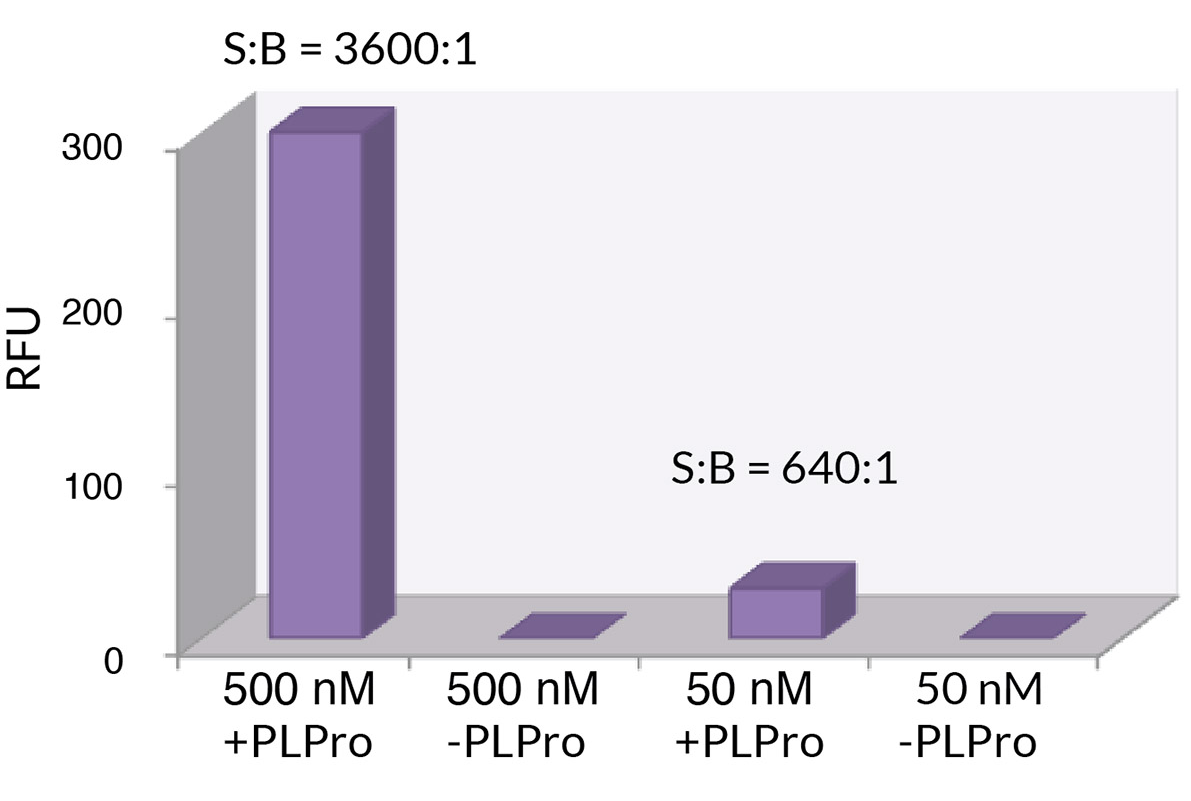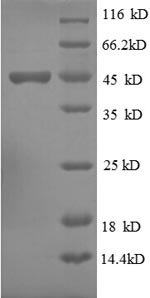
Signal to Background. The signal to background ratio was determined by 100% hydrolysis of either 50nM or 500nM ISG15-Rhodamine 110 to liberate the quenched conjugate. Assay Buffer: 50mM HEPES pH7.5, 100mM NaCl, 1mM TCEP, 0.1mg/ml BSA.
ISG15 (human) (rec.) (Rhodamine 110)
SBB-PS0002
Protein IDP05161
Product group Proteins / Signaling Molecules
Overview
- SupplierSouth Bay Bio
- Product NameISG15 (human) (rec.) (Rhodamine 110)
- Delivery Days Customer10
- CertificationResearch Use Only
- ConjugateTRITC
- Estimated Purity>97%
- Protein IDP05161
- Protein NameUbiquitin-like protein ISG15
- Scientific DescriptionISG15 (Interferon Stimulated Gene, 15kDa) is a ubiquitin-like modifier which initiates innate immune response by activating RIG-I signaling, stimulating NK-cell proliferation, inhibiting viral budding and acting as an IFNgamma-inducing cytokine. ISG15 contains two tandem ubiquitin homology domains and is cross-reactive with alpha-Ubiquitin antibodies. Conjugation of ISG15 to a substrate protein occurs through a ubiquitin like cascade via an E1 (UBE1L), E2 (UbcH8/UBE2L6) and E3 (not yet discovered.) Deconjugation normally occurs via UBP43 (USP18), however there are several viral proteases that are able to hydrolyze ISG15 conjugates in order to evade immune response. These include the OTU-containing protease of Crimean-Congo Hemorrhagic Fever nairovirus and the Papain-Like Protease (PLPro) of the SARS coronavirus. - Protein. Human ISG15 (aa1-157)conjugated at the C-terminus to a quenched Rhodamine 110 dye. Source: E. coli. Formulation: Liquid. In 50mM MES pH 6.0, 100mM sodium chloride, 10% glycerol. Purity: >97% (LCMS). ISG15 (Interferon Stimulated Gene, 15kDa) is a ubiquitin-like modifier which initiates innate immune response by activating RIG-I signaling, stimulating NK-cell proliferation, inhibiting viral budding and acting as an IFNgamma-inducing cytokine. ISG15 contains two tandem ubiquitin homology domains and is cross-reactive with alpha-Ubiquitin antibodies. Conjugation of ISG15 to a substrate protein occurs through a ubiquitin like cascade via an E1 (UBE1L), E2 (UbcH8/UBE2L6) and E3 (not yet discovered.) Deconjugation normally occurs via UBP43 (USP18), however there are several viral proteases that are able to hydrolyze ISG15 conjugates in order to evade immune response. These include the OTU-containing protease of Crimean-Congo Hemorrhagic Fever nairovirus and the Papain-Like Protease (PLPro) of the SARS coronavirus.
- Storage Instruction-80°C
- UNSPSC12352202



